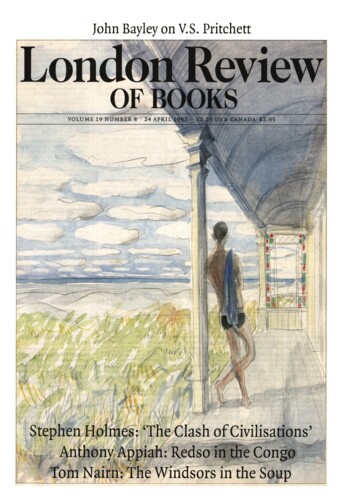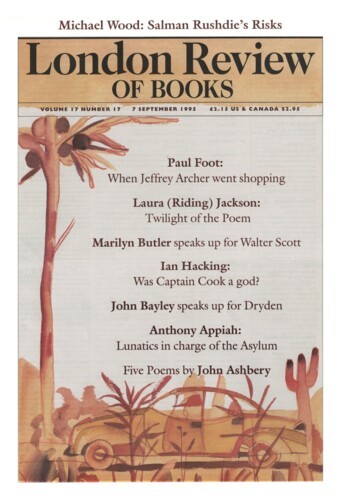Mokélé-Mbembe, being the Faithful Account of a Hazardous Expedition to find the Living African Dinosaur
Anthony Appiah, 24 April 1997
Redmond O’Hanlon’s account of a journey to Borneo, undertaken with the poet James Fenton, was a grand deception, in which the ostensible search for an indigenous rhinoceros on the slopes of a mountain fastness turned out to be so much camouflage. Clues as to what was really happening could be glimpsed in the structure of O’Hanlon’s narrative. Into the Heart of Borneo is a book burdened by its sense of belatedness; every moment is glossed as the repetition of some earlier natural historian’s triumph. Near the beginning, when he first sees Troides brookiana, a bird-wing butterfly, O’Hanlon cites Alfred Russel Wallace’s description of it as ‘one of the most elegant species known’. What he does not see is also carefully itemised, in the words of those earlier heroes whose eyes have gazed on the mysteries: ‘an owl, Glaucidium borneense, “about the size of one’s thumb”, as [Charles] Hose described it, which calls poop-te-poop-poop’; or a tiny hawk, Microhierax, which lays ‘a large white egg about as big as itself’. The book’s very form – the palimpsest of prose from so many predecessors-makes plain one fundamental impulse of the journey: O’Hanlon is on a pilgrimage in the footsteps of those natural historians and explorers who inhabited his doctoral thesis on ‘Changing Scientific Concepts of Nature in the English Novel’ in the late 19th and early 20th centuries. Everywhere he turns he sees the shade of Wallace (The Malay Archipelago: The Land of the Orang-Utan and the Bird of Paradise. A Narrative of Travel, with Studies of Man and Nature, 2 vols, 1869) and hears the footpad of Charles Hose (The Field-Book of a Jungle-Wallah, being a Description of Shore, River and Forest Life in Sarawak, 1929). These men are O’Hanlon’s real companions; he reads them by torchlight in his tent; he sees the world through their eyes, and confides in them, as he cannot always do in Fenton.


